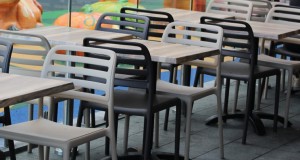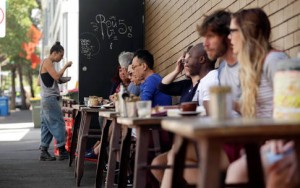Extend your café or restaurant outdoors
It is little wonder café and restaurant owners are falling over themselves to move their business to the street. Savvy operators see the potential of maximising profits by taking it to the pavement – instantly increasing covers with only a small amount of additional effort and cost.
Good for Community – Good for Business – Good for Council
It’s no secret that allowing cafes and restaurants to extend their dining space outside encourages people to engage with each other and the physical place around them.
Local Councils are increasingly supportive of outdoor dining to improve the streetscape of their community and offer more vibrant places to participate in street life.
“Outdoor dining creates an inclusive public place for people from all walks of life to interact.”
And, whilst the growth of outdoor café business is a valuable contribution to the social and cultural identity of an area, it also increases prosperity of the area with jobs and business growth.
Councils will often encourage clusters of cafes that compete for clientele to create a thriving café culture community atmosphere e.g Lygon Street in Melbourne or Llankelly Place, Potts Point in Sydney. The Sydney City alone has over 500 outdoor dining areas in every suburb.
“Expect to jump through some hoops – but its worth it”
Unfortunately, despite encouraging the growth of outdoor dining spaces, Councils will still make you jump through a few hoops before they let you put some chairs and tables on the footpath.
If you are not sure if your premises could use the footpath for dining – consider most councils require a minimum footpath space of 3.4 m to accommodate seating without interfering with pedestrians and other street activities. If there is existing infrastructure i.e bins, bicycle hoops etc in the way – it is worth asking council if they would consider relocating these items to allow for street seating.
What to expect – Outdoor Dining Regulations
Every council will have slightly different regulations and application processes and it is good to understand what you are getting yourself in to before you start looking for outdoor furniture.
For council a public place is defined as common ground and hence must benefit the ”public” and allow for pedestrian flow and movement. They adhere to a number of federal, state and municipal laws, which govern the use of public places including outdoor cafes.
At the minimum you will have to apply for a permit or licence and comply to an outdoor café policy for outdoor furniture, shade and barriers.
In some instances you may have to apply for a Development Consent (DA) by submitting a Development Application. For example, if your outdoor dining area:
- is associated with a pub
- provides seating for more than 20 people
- is used before 7am or after 10pm.
Costs for an outdoor seating licence will vary depending on the location and council – even within the City of Sydney, the costs are widely variable – in Circular Quay you will be paying $625 per year whilst in Oxford street it is $220.
If your café is on private property you may not need to apply for a DA but you will have to follow the guidelines published by council for safety and amenity checks.
How to Choose Furniture for Outdoor Dining & Pavement Seating
Councils will usually supply a guideline to the type and style of furniture for your outdoor dining area. Be sure to check with your individual Council before purchasing furniture.

As a guide expect specifications similar to the following:
- Tables, chairs, umbrellas and screens to be of a temporary nature i.e. only visible during operational hours. The may specify folding and/or stacking furniture that can be easily removed and stored indoor (away from public areas outside business hours or in bad weather)
- Outdoor Furniture that is an extension of indoor seating – check that the furniture you choose has some consistency with your indoor furniture
- Furniture that won’t cause damage to the pavement – with acceptable caps or feet that are not sharp
- Furniture that contributes and integrates with the street environment – they may even indicate colour schemes and styles
- Some councils may specify a requirement for shade umbrellas or cover including style and colour
- Non-reflective table tops are usually indicated and are a practical suggestion in non shaded outdoor areas to prevent glare
- Avoiding white table surfaces and chair seats are another practical suggestions to minimise to rapid discolouration/deterioration
- Most councils will ask you to avoid fencing and boundaries which “privatise the space”
- And to pass the “convenient pedestrian access” test check there is sufficient space for two mobility aids or child pushers to pass each other comfortably on the footpath. Each council may have different regulations but will supply will supply guidelines for minimum clearance.
If you need help choosing outdoor furniture that adheres to Local Council regulations visit Outdoor Furniture – Instyle Seating online or call our expert team on 1300 309 889. We can advise you an all facets of outdoor furniture, outdoor chairs and outdoor tables. Furniture can be supplied and fitted Australia wide.


